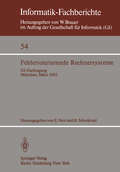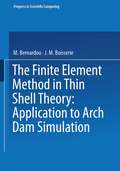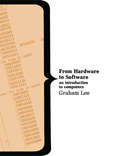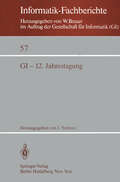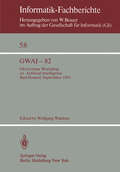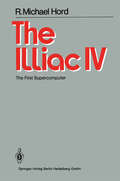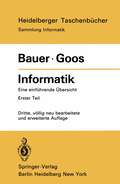- Table View
- List View
Biomedical Images and Computers: Selected Papers Presented at the United States-France Seminar on Biomedical Image Processing, St. Pierre de Chartreuse, France, May 27–31, 1980 (Lecture Notes in Medical Informatics #17)
by J. Sklansky J. C. BisconteThe technology of automatic pattern recognition and digital image processing, after over two decades of basic research, is now appearing in important applications in biology and medicine as weIl as industrial, military and aerospace systems. In response to a suggestion from Mr. Norman Caplan, ·the Program Director for Automation, Bioengineering and Sensing at the United States National Science Foundation, the authors of this book organized the first Uni ted States-France Seminar on Biomedical Image Processing. The seminar met at the Hotel Beau Site, St. Pierre de Chartreuse, France on May 27-31, 1980. This book contains most of the papers presented at this seminar, as weIl as two papers (by Bisconte et al. and by Ploem ~ al.) discussed at the seminar but not appearing on the program. We view the subject matter of this seminar as a confluence amon~ three broad scientific and engineering disciplines: 1) biology and medicine, 2) imaging and optics, and 3) computer science and computer engineering. The seminar had three objectives: 1) to discuss the state of the art of biomedical image processing with emphasis on four themes: microscopic image analysis, radiological image analysis, tomography, and image processing technology; 2) to place values on directions for future research so as to give guidance to agencies supporting such research; and 3) to explore and encourage various areas of cooperative research between French and Uni ted States scientists within the field of Biomedical Image Processing.
Büroinformations- und -kommunikationssysteme: Anwendergespräch, Wirtschaftsuniversität Wien, 30.9. bis 1.10.1982 (Betriebs- und Wirtschaftsinformatik #2)
by H. R. HansenCOMPSTAT 1982 5th Symposium held at Toulouse 1982: Part I: Proceedings in Computational Statistics
by H. Caussinus P. Ettinger R. TomassoneComputational Methods and Experimental Measurements: Proceedings of the International Conference, Washington D.C., July 1982
by G. A. Keramidas C. A. BrebbiaSponsored by the International Society for Computational Methods in Engineering
Computer Algebra: Symbolic and Algebraic Computation (Computing Supplementa #4)
by R. AlbrechtThe journal Computing has established a series of supplement volumes the fourth of which appears this year. Its purpose is to provide a coherent presentation of a new topic in a single volume. The previous subjects were Computer Arithmetic 1977, Fundamentals of Numerical Computation 1980, and Parallel Processes and Related Automata 1981; the topic of this 1982 Supplementum to Computing is Computer Algebra. This subject, which emerged in the early nineteen sixties, has also been referred to as "symbolic and algebraic computation" or "formula manipulation". Algebraic algorithms have been receiving increasing interest as a result of the recognition of the central role of algorithms in computer science. They can be easily specified in a formal and rigorous way and provide solutions to problems known and studied for a long time. Whereas traditional algebra is concerned with constructive methods, computer algebra is furthermore interested in efficiency, in implementation, and in hardware and software aspects of the algorithms. It develops that in deciding effectiveness and determining efficiency of algebraic methods many other tools - recursion theory, logic, analysis and combinatorics, for example - are necessary. In the beginning of the use of computers for symbolic algebra it soon became apparent that the straightforward textbook methods were often very inefficient. Instead of turning to numerical approximation methods, computer algebra studies systematically the sources of the inefficiency and searches for alternative algebraic methods to improve or even replace the algorithms.
Computer Communications
by R. COLEThe subject of computer communications is changing very rapidly. Improvements in terminal access, aligned with the development of timesharing, has brought hands-on experience to a large number of non specialist users. Computer networks have made available vast computing resources and data banks to these users. This book is for anyone familiar with using computers who wishes to understand the techniques used in computer communications. It is also an introduction to the architecture of present day computer communication systems. I would like to thank Roland lbbett, Steve Treadwell, Peter Kirstein and Del Thomas for their invaluable advice and encouragement. My thanks also to Malcolm Stewart and the staff at Macmillan. The late Gareth Pugh encouraged my interest in computer communications and provided the opportunity to develop the material for this book. The text was formatted on a UNIX computer system: I am grateful to Professor Kirstein for permission to use this system. I am indebted to NEC Telecommunications Europe for the use of a spinwriter printer on which the master copy was produced. Finally, no amount of words can express my debt to Jo this project and Rosemary for patiently bearing with over the last three years.
Computers and the General Practitioner: Proceedings of the GP-Info Symposium, London, 1980
by Alastair Malcolm John PoyserComputers and the General Practitioner focuses on the applications of computers in various aspects of health service, including ECG analysis, primary care, and diagnosis. The selection first tackles general practice and technological promise and experience of pioneers. Topics include information systems and general practice, trends in silicon chip technology, and problems of computer usage in National Health Service practice. The publication then examines security in computer controlled information systems and national strategy for primary care computing, including security defenses, linked systems, cryptography, and basic system. The text takes a look at the computer education of the general practitioner, use of computers in the consulting room, and ECG analysis by computer in general practice. Discussions focus on the problems associated with educating doctors, features of a heuristic system, and the function of the computer as a general practitioner's diagnostic assistant. The selection is a dependable source of data for doctors and readers interested in exploring the applications of computers in health services.
Die endliche Fourier- und Walsh-Transformation mit einer Einführung in die Bildverarbeitung: Eine anwendungsorientierte Darstellung mit FORTRAN 77-Programmen
by Klaus NiederdrenkDigital Picture Processing (Computer Science and Scientific Computing #Volume 2)
by Azriel RosenfeldDigital Picture Processing
Digital Picture Processing (Computer Science and Applied Mathematics #Volume 1)
by Azriel Rosenfeld Avinash C. KakThe rapid rate at which the field of digital picture processing has grown in the past five years had necessitated extensive revisions and the introduction of topics not found in the original edition.
Einführung in die Programmiersprache BASIC: Anleitung zum Selbststudium ; Skriptum für Hörer aller Fachrichtungen ab 1. Semester
by Wolf-Dietrich SchwillEinführung in die Programmiersprache PASCAL: Skriptum für Hörer aller Fachrichtungen ab 1. Semester
by Karl-Heinz BeckerEinführung in die Programmiersprache SIMULA: Anleitung zum Selbststudium
by Günther LamprechtDiese Einführung in die Programmiersprache SIMULA ist aus Lehrveranstaltungen entstanden, die seit mehreren Jahren am Rechenzentrum der Universität Bremen abgehalten wurden. Das Buch wendet sich an .,Hörer aller Fakultäten" und will ihnen den Zugang zur Datenverarbeitung an Hand einfacher Aufgabenstellungen erleichtern. Die Programmiersprache SIMULA, die am Norwegian Computing Center von 0. J. Dahl, B. Myhrhaug und K. Nygaard entwickelt wurde, ist eine Erweiterung der Programmiersprache ALGOL 60. Die Sprache bietet eine Fülle von Anweisungen, so daß man den Lösungsweg auch bei komplexer Aufgabenstellung übersichtlich beschreiben kann. Das Ziel dieser Einführung in die Programmiersprache SIMULA ist es, den Leser nach und nach mit den Sprachelementen vertraut zu machen. Dabei kommt es weniger darauf an, die Sprache vollständig zu beschreiben, als vielmehr, beispielhaft zu zeigen, wie man die einzelnen Anweisungen anwenden kann. Die Programmierbeispiele und Aufgaben wurden auf der Rechenanlage Siemens 7.880 der Universität Bremen gerechnet und die Ergebnisse im Lösungsteil angegeben und erläutert. Damit hat der Leser die Möglichkeit, seine eigenen Programme und Ergebnisse zu kontrollieren. Herrn Dr. Lohmann möchte ich für die Durchsicht des Manuskripts und Frau U. Kleinschmidt für ihre Sorgfalt beim Schreiben der Druckvorlagen danken. Bremen, im April 1982 G. Lamprecht -I- 1 Ein einfaches Programmierbeispiel Es soll mit Hilfe der Rechenanlage die Funktion 2 y = 0,3 x + 0,25 x - I an der Stelle x = 0,5 berechnet werden. Wie man leicht nachrechnen kann, muß das Ergebnis -0,8 lauten. Das SIMULA-Programm soll angegeben und anschließend erläutert werden.
Einführung in PASCAL: Mit zahlreichen Beispielen und 10 vollständigen Programmen (Programmieren von Mikrocomputern #4)
by Wolfgang SchneiderErzeugung interaktiver Bildverarbeitungssysteme im Dialog: Konzepte, Entwurf und Implementierung eines Dialogsystems für die Bildverarbeitung in der Medizin (Informatik-Fachberichte #51)
by G. PfeifferThe Expression of Knowledge: Neurobehavioral Transformations of Information into Action
by Robert L. Isaacson Norman E. SpearWhat we know about the world and its opportunities limits what we do. If we do not know that there is a pot of gold at the end of the rainbow, we will not follow it. If we do not know that a desert cactus contains water, we will not cut into it for sustenance. Often, however, we do know things about the world and yet the knowledge does not seem to be reflected in behavior. Explaining this fact simply in terms of inadequate motivation for expression or incomplete memory for the important in formation does not really add much to our understanding. The ex pression of knowledge can be interrupted in very special ways by a variety of more specific conditions-fatigue, sources of forgetting that may include failure of memory retrieval, emotion, and various dysfunc tions of brain and body systems-that are not satisfactorily incorporated by any current theories of motivation or memory. Also, a dissociation between knowledge and its expression can take the form of applying knowledge without apparent awareness of this action, a phenomenon that requires complicated assumptions for explanation in terms of either motivation or memory. Dissociations between knowledge and action may be striking. After driving home on a familiar route we may not be able to report whether the last three traffic lights were red or green; yet we must have re sponded appropriately to them.
Fehlertolerierende Rechnersysteme: GI-Fachtagung München, 11.–12. März 1982 Gemeinsam veranstaltet von GI-Fachausschuß 8 und Fachausschuß 11 und GMD-Institut für Rechner- und Programmstrukturen, Siemens AG (Informatik-Fachberichte #54)
by E. Nett Heinz SchwärtzelThe Finite Element Method in Thin Shell Theory: Application to Arch Dam Simulations (Progress in Scientific Computing #1)
by Bernardou Boisserie~his Monograph has two objectives : to analyze a f inite e l e m en t m e th o d useful for solving a large class of t hi n shell prob l e ms, and to show in practice how to use this method to simulate an arch dam prob lem. The first objective is developed in Part I. We record the defi- tion of a general thin shell model corresponding to the W.T. KOlTER linear equations and we show the existence and the uniqueness for a solution. By using a co nform ing fi nite e l e m ent me t hod , we associate a family of discrete problems to the continuous problem ; prove the convergence of the method ; and obtain error estimates between exact and approximate solutions. We then describe the impl em enta t ion of some specific conforming methods. The second objective is developed in Part 2. It consists of applying these finite element methods in the case of a representative practical situation that is an arc h dam pro b le m. This kind of problem is still of great interest, since hydroelectric plants permit the rapid increase of electricity production during the day hours of heavy consumption. This regulation requires construction of new hydroelectric plants on suitable sites, as well as permanent control of existing dams that may be enlightened by numerical stress analysis .
GI-12. Jahrestagung: Kaiserslautern, 5.–7. Oktober 1982 Proceedings (Informatik-Fachberichte #57)
by J. NehmerDie 12. Jahrestagung der Gesellschaft für Informatik an der Univer sität Kaiserslautern steht unter dem thematischen Schwerpunkt nSYSTEMS ENGINEERING" in der Informatik. Unter dem Druck einer sehr geringen Zahl einge reichter Beiträge sind wir von dem Konzept der Vorjahre abgerückt, die Tagung überwiegend aus eingereichten Beiträgen zu bestreiten. Der zweite Tag hat durch die eingeladenen tfbersichtsvorträge einen vor wiegend tutorialen Charakter und soll der Jahrestagung gegenüber den vielen Fachtagungen eine eigenständige Attraktivität verleihen. Die in tfbersichtsvorträgen behandelten Themen sollen den hier anwesenden Fachleuten Gelegenheit bieten, sich bequem über außerhalb des eigenen Arbeitsgebiets sich abzeichnende neue Entwicklungen zu informieren. Dem Programmkomitee, den Programmausschüssen der Fachgespräche sowie dem Organisationskomitee am Tagungsort sei an dieser Stelle für ihren Beitrag zum Gelingen der Tagung herzlich gedankt. Kaiserslautern, Juli 1982 Jürgen Nehmer FOLGENDE FIRMEN HABEN DIE VORBEREITUNG UND AUSRICHTUNG DER TAGUNG FINANZIELL UNTERSTÜTZT: SIEMENS AG IBM DEUTSCHLAND GMBH BASF AG BROWN, BOVERI & CIE. AG TELEFONBAU & NORMALZEIT GMBH GEBR. KITTELBERGER GMBH & CO.
GWAI-82: 6th German Workshop on Artificial Intelligence Bad Honnef, Sept. 27. – Oct. 1, 1982 (Informatik-Fachberichte #58)
by W. WahlsterThe Illiac IV: The First Supercomputer
by R.M. HordThe Illiac IV was the first large scale array computer. As the fore runner of today's advanced computers, it brought whole classes of scientific computations into the realm of practicality. Conceived initially as a grand experiment in computer science, the revolutionary architecture incorporated both a high level of parallelism and pipe lining. After a difficult gestation, the Illiac IV became operational in November 1975. It has for a decade been a substantial driving force behind the develooment of computer technology. Today the Illiac IV continues to service large-scale scientific aoolication areas includ ing computational fluid dynamics, seismic stress wave propagation model ing, climate simulation, digital image processing, astrophysics, numerical analysis, spectroscopy and other diverse areas. This volume brings together previously published material, adapted in an effort to provide the reader with a perspective on the strengths and weaknesses of the Illiac IV and the impact this unique computa tional resource has had on the development of technology. The history and current status of the Illiac system, the design and architecture of the hardware, the programming languages, and a considerable sampling of applications are all covered at some length. A final section is devoted to commentary.


















